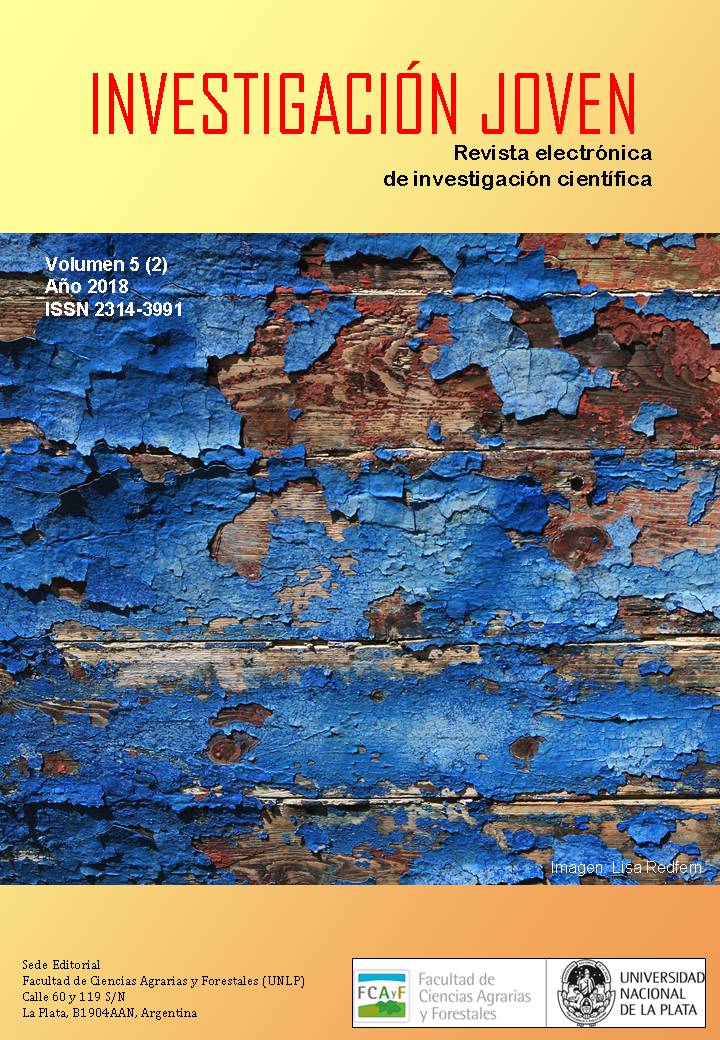Pinturas EPOXI base agua con fosfatos comerciales como pigmentos anticorrosivos
Palabras clave:
Corrosión, SAE 1010, ZCPP, ZAPP, ElectroquímicaResumen
La aplicación de pinturas anticorrosivas es uno de los métodos de protección más ampliamente empleados para evitar la corrosión del acero. Tradicionalmente, las pinturas se han formulado con disolventes orgánicos y pigmentos anticorrosivos tóxicos. En la actualidad uno de los objetivos del área es desarrollar nuevas formulaciones de pinturas en las cuales los solventes orgánicos sean reemplazados por agua.
El presente trabajo tuvo como objetivo desarrollar formulaciones y elaborar pinturas epoxi de base acuosa con fosfatos de segunda y tercera generación como pigmentos anticorrosivos. La caracterización electroquímica del acero pintado se llevó a cabo por: medidas de conductividad, ensayos de polarización lineal y medidas del potencial de corrosión. La película de pintura ensayada fue evaluada según norma de ampollado (ASTM D714-02) y corrosión (ASTM D610-08) luego de realizados los ensayos electroquímicos.
Los resultados muestran que las pinturas de base acuosa formuladas y preparadas proporcionan propiedades anticorrosivas aceptables.
Referencias
M. Bethencourt, J. Botana, M.J. Cano, R.M Osuna, M. Marcos-Bárcena, “Comportamiento anticorrosivo de pinturas de base agua aplicadas en aceros”, Bol. Soc. Esp. Ceram. 43, 2004, 209-211.
M. Hernández, J. Genescá, J. Uruchurtu, F. Galliano, D. Landoltd, “Effect of an inhibitive pigment zinc-aluminum-phosphate (ZAP) on the corrosion mechanisms of steel in waterborne coatings”, Prog. Org. Coat. 56, 2006, 199-206.
R. Duraisamy, T. Vasudevan, “Evaluation of Corrosion Stability of Water Soluble Epoxy-Ester Primer through Electrochemical Studies”, Mater. Sci. Appl. 3, 2012, 333-347.
S.N. Roselli, R. Romagnoli, C. Deyá, “The anti-corrosion performance of water-borne paints in longtermtests”, Prog. Org. Coat. 109, 2017, 172-178.
G. Reinhard, “Formulation of water-borne dispersions for corrosion-protective primers”,Prog. Org. Coat. 18, 1990, 123-145.
B. delAmo, R. Romagnoli, C. Deyá, J.A. González, “High performance water-basedpaintswith non-toxicanticorrosivepigments”, Prog. Org. Coat. 45, 2002, 389-397.
N. Wang, Y. Zhang, J. Chen, J. Zhang, Q. Fang, “Dopaminemodified metal-organicframeworkson anti-corrosionproperties of waterborneepoxycoatings”, Prog. Org. Coat. 109, 2017, 126-134.
B. Bieganska, M. Zubielewicz, E. Smieszek, “Anticorrosivewater-borne paints”, Prog.Org. Coat. 15, 1987, 33-56.
J. Sinko, “Challenges of chromate inhibitor pigments replacement in organic coatings”, Prog. Org. Coat. 42, 2001, 267-282.
F. Korać, S. Gutić, I. Zukić, J. Ostojić, S. Herenda, S. Gojak-Salimović, “Anticorrosion Performance of eco-friendly Paint Coatings”, Bull. Chem. Tech. B&H. 41, 2013, 37-47.
S. N. Roselli, G. Lendvay-Györik, G. Mészáros, C. Deyá, R. Romagnoli, “Anticorrosive water borne paints free from zinc and with reduced phosphate content”, Prog. Org. Coat. 112, 2017, 27-36.
M.R. Heydarpour, A. Zarrabi, M.M. Attar, B. Ramezanzadeh, “Studying the corrosion protection properties of an epoxy coating containing different mixtures of strontium aluminum polyphosphate (SAPP) and zinc aluminum phosphate (ZPA) pigments”, Prog. Org.Coat. 77, 2014, 160-167.
M.C. Deyá, G. Blustein, R. Romagnoli, B. delAmo, “The influence of the anion type on the anticorrosive behaviour of inorganic phosphates”,Surf. Coat. Technol. 150, 2002, 133-142.
A.O. S. Leite, W.S. Araújo, I.C.P. Margarit, A.N. Correia, P. de Lima-Neto, “Evaluation of the Anticorrosive Properties of Environmental Friendly Inorganic Corrosion Inhibitors Pigments”, J. Braz. Chem. Soc. 16, 2005, 756-762.
D.Veselý, V. Jašková, “Efficiency of anticorrosive pigments based on metal phosphates”
Transfer inovácií 15, 2009, 151-158.
V.F. Vetere, M.C. Deyá, R. Romagnoli, B. delAmo, “Calcium tripolyphosphate: An anticorrosive pigment for paint”, J. Coat. Technol. 73, 2001, 57-63.
M.C. Deyá, V.F. Vetere, R. Romagnoli, B. delAmo, “Zinc tripolyphosphate: An anticorrosive pigment for paints”, Surf. Coat. Int. B Coating Trans. 86, 2003, 79-85.
M. Deyá, A.R Di Sarli, B. del Amo, R. Romagnoli, “Performance of Anticorrosive Coatings Containing Tripolyphosphates in Aggressive Environments”, Ind. Eng. Chem. Res. 47, 2008, 7038–7047.
R. Naderi, M.M. Attar, “The inhibitive performance of polyphosphate-based anticorrosion pigments using electrochemical techniques”, Dyes and Pigm. 80, 2009, 349-354.
R. Naderi, M.M. Attar, “Electrochemical assessing corrosion inhibiting effects of zinc aluminum polyphosphate (ZAPP) as a modified zinc phosphate pigment”, Electrochim. Acta 53, 2008, 5692-5696.
S.M. Mousavifard, P. MalekMohammadi Nouri, M.M. Attar, B. Ramezanzadeh, “Theeffects of zinc aluminumphosphate (ZPA) and zinc aluminumpolyphosphate (ZAPP) mixtures oncorrosioninhibition performance of epoxy/polyamidecoating”, J. Ind. Eng. Chem. 19, 2013, 1031-1039.
G. Blustein, M.C Deyá, R. Romagnoli, B. delAmo, “Three generations of inorganic phosphates in solvent and water-borne paints: A synergism case”, Appl. Surf. Sci. 252, 2005, 1386-1397.
J.N Murray, “Electrochemical test methods for evaluating organic coatings on metals:An update. Part I Introduction and generalities regarding electrochemical testing of organiccoatings”, Prog. Org. Coat. 30, 1997, 225-233.
H.Leidheiser Jr.,“Electrical and electrochemical measurements as predictors of corrosion at the metal-organic coating interface”,Prog. Org. Coat. 7, 1979, 79-104.


















